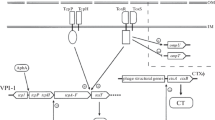Abstract
The conjugative recombinant plasmid plEM3 (KmR TcR) was constructed in order to introduce a cloned ctxB gene encoding the cholera toxin (CT) B subunit into Vibrio cholerae cells. The plasmid was obtained by cointegration of two plasmids: a conjugative plasmid, pIEMI (KmR), carrying mini-kan transposon and IS1 element, and pCTΔ27 (TcR) plasmid, a derivative of the BR322 carrying the cloned ctxB gene. The avirulent Vibrio cholerae strain ftTetr biovar devoid, as follows from PCR analysis, of key structural and regulatory genes allowing for pathogenesis and carrying a mutation in one of the O1-antigen genes was chosen as a pIEM3 plasmid carrier strain. Uncoupling of the cointegrated construction occurs in 5% of Vibrio cholerae cells, retaining only the multicopy pCTΔ27 plasmid. This leads to the appearance of TcRKmS clones producing the secreted B subunit of CT at a high level (10 to 14 g/ml). One of these clones (KM93) was selected as a producer strain of this protein. Patterns of inheritance and expression of a cloned ctxAB gene in KM93 cells were studied by molecular-genetic and biochemical assays. It was found that expression of a cloned ctxB gene did not depend on the presence of key regulatory genes of toxRt tcpP, tcpH, toxT in the chromosome, suggesting the existence of some other mechanisms that might control transcriptional activity of the cholera toxin B subunit gene. Effective production of the B subunit of the CT was also obtained upon rearing the constructed producer strain under the conditions of industrial process.
Similar content being viewed by others
References
Gintzburg, A.L., Yanishevski, N.V., Motin, V.L., et al., Molekulyarnaya Genetika (Molecular Genetics), 1984, no. 9, pp. 1–18.
Ilyina, T.S., Molekulyarnaya Genetika (Molecular Genetics), 2001, no. 1, pp. 3–12.
Maniatis, T., Fritsch, E., and Sambrook, J., Molecular Cloning: A Laboratory Manual, New York: Cold Spring Harbor Laboratory, 1982.
Osin, A.V., Nefedov, K.S., Yeroshenko, G.A., and Smirnova, N.I., Genetika (Genetics), 2005, vol. 41, no. 1, pp. 1–10.
Smirnova, N.I. and Kutyrev, V.V., Molekulyarnaya Genetika (Molecular Genetics), 2004, no. 4, pp. 3–13.
Yanishevski, N.V., Gintzburg, A.L., Vertiev, Yu.V., et al., Molekulyarnaya Genetika (Molecular Genetics), 1987, no. 4, pp. 26–31.
Bhattachaiya, T., Chatterjee, S., Maiti, D., et al., Environ. Microbiol., 2006, vol. 8, no. 3, pp. 526–534.
Bina, J., Zhu, J., Dziejman, M., et al., Proc. Natl. Acad. Sci. USA, 2003, vol. 100, no. 5, pp. 2801–2806.
Bradley, D.E., Taylor, D.E., and Cohen, D.R., J. Bacteriol., 1980, vol. 143, no. 3, pp. 1466–1470.
Bramucei, M.G. and Holmes, K.K., J. Clin. Microbiol., 1978, vol. 2, no. 2, pp. 232–239.
Chatterjee, S.N. and Chaudhuri, K., Biochim. Biophys. Acta, 2006, vol. 1762, pp. 1–16.
Craig, I.P., Nature, 1965, vol. 207, no. 4997, pp. 614–616.
Davis, B.M., Lawson, E.H., Sandkvist, M., et al., Science, 2000, vol. 288, no. 24, pp. 333–335.
De, S.N. and Chatterjee, D.N., J. Pathol. Bacteriol., 1953, vol. 66, no. 2, pp. 559–562.
Dutta, N.K. and Habbu, M.K., J. Pharmacol., 1955, vol. 10, no. 3, pp. 153–159.
Faruque, S.M., Rahman, M.M., and Hasan, A.K.M.M., Infect. and Immun., 2001, vol. 69, no. 10, pp. 6084–6090.
Fields, P.I., Popovic, T., Wachsmuth, K., and Olsvik, O., J. Clin. Microbiol., 1992, vol. 30, no. 6, pp. 2118–2121.
Garg, P., Aydanian, A., Smith, D., et al., Emerg. Infect. Dis., 2003, vol. 9, no. 7, pp. 810–814.
Laemmll, U.K., Nature, 1970, vol. 227, no. 3, pp. 680–685.
McLeod, S.M., Kimsey, H.H., Davis, B.M., and Waldor, M.K., Mol. Microbiol., 2005, vol. 57, no. 2, pp. 347–356.
Marinaro, M., Tommaso, A.D., Uzzau, S., et al., Infect. and Immun., 1999, vol. 67, no. 3, pp. 1287–1291.
Nesper, J., Kapfhammer, B., Klose, K.E., et al., J. Bacteriol., 2000, vol. 182, no. 18, pp. 5097–5104.
Provenzano, D. and Klose, K.E., Proc. Natl. Acad. Sci. USA, 2000, vol. 97, no. 18, pp. 10220–10224.
Salles, C.A., Momen, H., Vicente, A.C.P., and Coelha, A. Trans. Roy. Soc. Trop. Med. Hyg., 1993, vol. 87, no. 1, p. 272.
Singh, D.V., Matte, M.H., Matte, G.R., et al., Appl. Environ. Microbiol., 2001, vol. 67, no. 2, pp. 910–921.
Svennercholm, A.M. and Holmgren, J., Curr. Microbiol., 1978, vol. 1, no. 3, pp. 19–23.
Teter, K., Jobling, M.G., Sentz, D., and Holmes, R.K., Infect. and Immun., 2006, vol. 74, no. 4, pp. 2259–2267.
Waldor, M.K. and Mekalanos, J.J., Science, 1996, vol. 272, no. 28, pp. 1910–1914.
Way, J.C., Davis, M.A., Mohsato, B., et al., Gene, 1984, vol. 32, no. 2, pp. 369–379.
Author information
Authors and Affiliations
Additional information
Original Russian Text © N.I. Smirnova, I.M. Krepostnova, L.F. Livanova, S.P. Zadnova, S.A. Eremin, T.S. Il’ina, 2007, published in Molekulyarnaya Genetika, Mikrobiologiya i Virusologiya, 2007, No. 4, pp. 7–13.
About this article
Cite this article
Smirnova, N.I., Krepostnova, I.M., Livanova, L.F. et al. An avirulent Vibrio cholerae strain—A producer of the cholera toxin B subunit: Obtainment and molecular genetic analysis. Mol. Genet. Microbiol. Virol. 22, 142–149 (2007). https://doi.org/10.3103/S0891416807040027
Received:
Issue Date:
DOI: https://doi.org/10.3103/S0891416807040027



